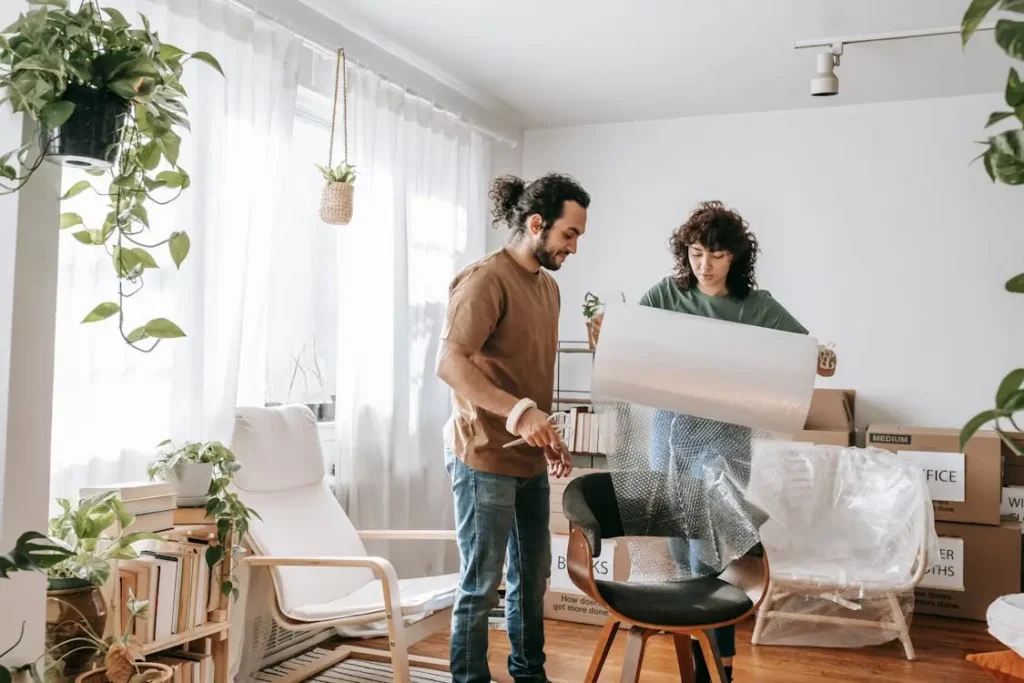Comprehensive Safety Guidelines for Packing: A Stress-Free Moving Experience
Table of Contents
Why Safety Guidelines for Packing Are Crucial
Understanding and following safety guidelines for packing is essential to protecting your belongings and ensuring your safety during a move. Proper techniques and precautions can prevent injuries and damage, making the moving process more efficient and less stressful. This guide provides comprehensive safety tips to help you pack effectively and safely.

Preparing for Packing
Gathering the Right Supplies for Safety Guidelines for Packing
Essential Packing Materials
- Sturdy Boxes: Use high-quality boxes in various sizes to accommodate different items. Avoid using old or damageboxes, es as they may not provide adequate protection.
- Packing Tape: Invest in strong, durable tape to secure your boxes properly. Reinforce the bottom of each box with extra tape to prevent it from collapsing.
- Bubble Wrap and Packing Paper: Protect fragile items with ample cushioning. Use bubble wrap for extra padding and packing paper to fill empty spaces in boxes.
- Markers: Clearly label each box to indicate its contents and handling instructions. Use a bold, legible marker to ensure labels are easily readable.
Personal Protective Equipment (PPE) for Safe Packing
- Gloves: Protect your hands from cuts and abrasions. Choose gloves with a good grip to handle items securely.
- Safety Glasses: Shield your eyes when dealing with sharp objects or chemicals. Safety glasses are particularly important when handling items that could shatter.
- Proper Footwear: Wear closed-toe shoes with a good grip to prevent injuries. Avoid sandals or flip-flops, as they offer little protection against dropped items.
Creating a Safe Packing Environment with Safety Guidelines for Packing
- Clear and Organized Workspace
- Declutter: Keep the packing area free from unnecessary items to avoid trips and falls. Designate a specific area for packing to keep things organized.
Workstations: Set up designated areas for packing different categories of items.
This helps maintain order and ensures that items are packed efficiently.
- Proper Lighting for Safe Packing
- Adequate Illumination: Ensure your workspace is well-lit to see clearly and prevent accidents. Good lighting helps you identify and handle items safely.
- Portable Lights: Use additional lights if necessary to enhance visibility. Consider using LED lamps for bright, focused lighting.

Safe Packing Techniques
Lifting and Carrying Boxes Safely
Correct Lifting Posture for Following Safety Guidelines for Packing
- Bend at the Knees: Avoid bending at the waist to prevent back strain. Squat down, keep your back straight, and use your legs to lift.
- Lift with Your Legs: Use the strength of your legs to lift heavy objects. This technique reduces the risk of back injuries.
- Hold Close to Your Body: Keep the box close to your torso for better balance. Holding items close helps maintain stability and control.
Weight Limits for Safe Packing
- 50-Pound Limit: Aim for a maximum weight of 50 pounds per box to avoid overexertion. Overloading boxes can lead to injuries and themes difficult to carry.
- Distribute Weight Evenly: Ensure boxes are balanced and not top-heavy. Evenly distributed weight makes boxes easier to handle and less likely to tip over.
Packing Fragile Items Following Safety Guidelines for Packing
Using Protective Materials
- Bubble Wrap: Wrap each fragile item individually. Ensure that items are completely covered to prevent breakage.
- Packing Paper: Fill empty spaces in boxes with packing paper to prevent movement. Use plenty of paper to cushion items and keep them secure.
- Labeling Boxes
- Fragile: Clearly mark boxes containing delicate items. Use large, bold lettering to indicate that the contents need careful handling.
- This Side Indicates the proper orientation for handling. Ensure that arrows or instructions are visible on all sides of the box.
Securing Sharp and Hazardous Items with Safety Guidelines for Packing
Proper Wrapping
- Sharp Objects: Wrap knives and tools in protective coverings. Use thick materials, like bubble wrap or foam, to prevent punctures.
- Tape Blades: Securely tape the blades of scissors and other sharp items. Ensure that the tape is strong enough to hold during transit.
Handling Hazardous Materials
Regulations: Check regulations for moving hazardous materials, as some items may require special handling or may not be allowed. This includes items like paint, gasoline, and certain chemicals.
- Separate Packing: Pack hazardous items separately and label them clearly. Use sturdy, leak-proof containers and ensure they are properly sealed.

Packing Room by Room with Safety Guidelines for Packing
Safety Guidelines for Packing in the Kitchen
Glassware and Dishes
- Cell Boxes: Use cell boxes designed for glassware. These boxes have individual compartments to protect each item.
- Vertical Packing: Pack plates vertically to reduce breakage risk. Use padding between each plate to prevent them from clinking together.
Appliances
- Secure Loose Parts: Tape down any loose parts. For example, secure the turntable in a microwave oven.
- Wrap Cords: Securely wrap cords around appliances. Use twist ties or rubber bands to keep cords from dangling.
Safety Guidelines for Packing in the Living Room
Electronics
- Original Boxes: Use original boxes if available. These boxes are designed to fit and protect the items perfectly.
- Padding: Ensure adequate padding to protect electronics. Use bubble wrap, packing paper, or foam to cushion items.
Furniture
- Disassemble: Disassemble large furniture pieces. This makes them easier to move and reduces the risk of damage.
Label Hardware: Keep screws and bolts in labeled bags. Tape the bags to the furniture pieces they belong to.
Safety Guidelines for Packing in the Bedroom
- Clothing
- Wardrobe Boxes: Use wardrobe boxes for hanging clothes. These boxes have a built-in rod to keep clothes wrinkle-free.
- Suitcases: Pack folded clothes in suitcases or boxes. This maximizes space and makes use of existing luggage.
Bedding and Linens
- Plastic Bags: Pack bedding in clear plastic bags. This protects them from dust and dirt during the move.
- Vacuum-Seal Bags: Use vacuum-seal bags to save space. These bags compress bulky items like comforters and pillows.
Safety Guidelines for Packing in the Bathroom
Toiletries
- Seal Liquids: Place liquid toiletries in plastic bags to prevent spills. Ensure lids are tightly closed and consider taping them shut.
- Essentials Bag: Pack an essentials bag for easy access. Include items you will need immediately after the move, such as toothpaste and soap.
Medicine
- Secure Storage: Transport prescription medications separately in a secure place. Keep them in their original containers and pack them in a labeled bag.
Final Checks and Safety Measures
Securing Boxes for Transport with Safety Guidelines for Packing
Sealing Boxes Properly
- Packing Tape: Use strong tape to seal boxes on the top and bottom. Reinforce the seams and corners for extra strength.
- Reinforce Seams: Double-tape seams for extra security. This helps prevent boxes from opening during transit.
Stacking Boxes Safely
- Heavy on Bottom: Place heavier boxes at the bottom of stacks. This provides a stable base and prevents lighter boxes from being crushed.
- Stable Stacks: Ensure stacks are stable and not too high. Unstable stacks can topple over, causing damage and injury.
Personal Safety Tips for Following Safety Guidelines for Packing
Taking Breaks
- Regular Intervals: Take breaks to avoid fatigue. Moving can be physically demanding, so rest periodically to maintain energy.
- Stay Hydrated: Drink water frequently to stay hydrated. Dehydration can lead to fatigue and dizziness.
Asking for Help
- Teamwork: Don’t hesitate to ask for assistance with heavy or awkward items. Working with others can make the process safer and more efficient.
- Professional Movers: Consider hiring professional movers for particularly challenging items. Their expertise and equipment can prevent injuries and damage.
Conclusion
Recap of Key Safety Guidelines for Packing
Following these safety guidelines for packing ensures a safer and more efficient packing process. Proper preparation, safe packing techniques, and attention to personal safety are essential for a successful move. Adhering to these guidelines helps protect your belongings and minimizes the risk of injury.
Encouragement to Prioritize Safety Guidelines for Packing
Prioritize safety during your move to protect your belongings and well-being. By taking the time to pack carefully and following these guidelines, you can enjoy a smoother, safer moving experience. Remember, a little extra effort in preparation can prevent a lot of trouble later on.

